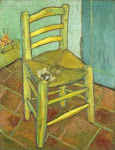The van Gogh offered at last night's auction indeed did not sell, and neither did 13 other lots (including two Monets). The sale did break an auction record for Monet with another painting, though, an early canvas of the railroad bridge at Argenteuil. It went for $41.5 million. The news-stories today focused on that and tended to say little about the lots that did not sell. Christopher Burge, honorary Christie's chairman and last night's auctioneer, was quoted in the Associated Press commenting about the van Gogh. Paraphrasing a bit, he pointed out that van Gogh's Paris-period works are not as expensive as his later works, and he suggested Christie's may have aimed too high in the estimate.
He's right about the Paris-period canvases (March 1886-Feb 1888): not only are they not as expensive compared to those painted in Arles, Saint-Rémy, or Auvers-sur-Oise, they're also not as famous. The Paris period tends to get lost between the luminous color of 1888-1890 and the murky earth tones of Vincent's time in Holland. And yet, without those two years, it is unlikely van Gogh would have found the style that people today know so well, and in fact, he might not have gone to Provence at all. Formatively, the Paris period was crucial. For the first time, Vincent saw Impressionist paintings; he arrived in Paris in time for the last "official" Impressionist exhibition (most famous for the inclusion of Seurat's "Sunday Afternoon on the Island of La Grande Jatte"). He met a gaggle of contemporary artists whose work opened his eyes to new possibilities of color: Paul Signac, Émile Bernard, Henri de Toulouse-Lautrec, Lucien Pissarro (son of Camille), among others, and briefly, Paul Gauguin. Vincent's brother Theo provided him with an entrée into a world he would not have found in the Netherlands.
And in the Paris-period works, you can see Vincent struggling to find his own voice in the midst of all these new stimuli. He flirts with pointillism -- but his restless character wasn't going to let him make tiny dots all day. He continues to absorb the influence of Japanese prints, an interest which he first discovered in Antwerp and was able to further explore in Paris. He treats subjects that have always interested him in new ways; one day he's painting the interior of a Paris café, the next he's tramping over the back of the butte Montmartre looking for glimpses of the countryside.
But it all got to be too much. Vincent later says that he was "nearly an alcoholic" by the time he left Paris, exhausted by the city. Hence the flight to Provence, and a desire to see things in a different light. He moved on, and so did his painting.
Subscribe to:
Post Comments (Atom)






No comments:
Post a Comment